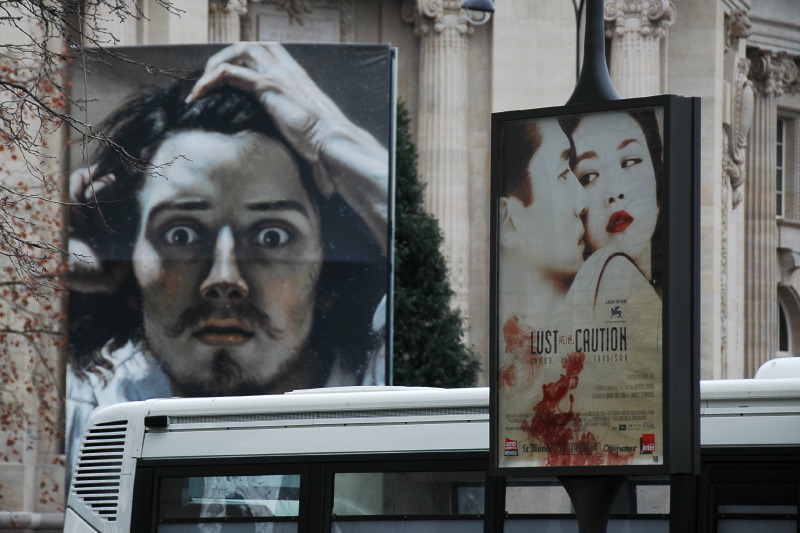 |
Pictured: Courbet at the Grand Palais in Paris |
Paris in January means winter sales, patisserie windows filled with golden Galettes des Rois and their accompanying pasteboard crowns, and less of a press during the morning Metro commute, with many residents away on their winter holiday.
This winter in Paris, however, also included a trio of museum exhibitions with tangled intersections. Call it a perfect triangle of expression, repression, and technique:
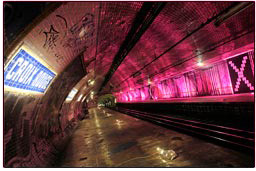 |
 |
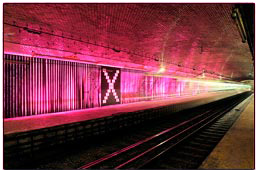 |
| Pictured: A temporary installation, along Metro Line 10, at the disused Croix-Rouge station, to advertise l'Enfer. (Courtesy of the RATP.) |
“Hell at the Library: Eros in Secret,” features more than 350 items from the Bibliothèque Nationale’s l’Enfer (“Hell”) — contraires aux bonnes mœurs — collection of persecuted, condemned, and suppressed works dating back to the 1830s.
The exhibit dwells in strange synergy with its external, post-modern environment: four great vertical slabs which comprise the national library’s François-Mitterrand branch, located in the industrial southeast of Paris. It was made the more uninviting one recent morning by gusts of horizontal-driving rain and the escalator’s slow descent toward subterranean metal girders. Inside, however, is a different story. L’Enfer, dubbed a celebration of eroticism and sex — not to mention (and I'm quoting ...) fantasy and desire, politics and pornography — highlights its curios under warm red gas lights, in immaculately constructed cases, as flames flicker on the far wall behind saturated enlargements of locked card catalogs, catalogs written in Victorian script, and hand-tooled leather bindings.
The array and format of sixteenth to twentieth-century material includes many banned, suppressed, or clandestinely published books from the likes of Georges Bataille, Pierre Guyotat, and Sade. Also included: Victorian-era prints, flipbooks, classical engravings offered in both public and private versions, illustrations of various Greek (im)morality tales, and a set of 12 photographic calling cards of Parisian madams. (One enterprising Parisian collected them all.)
The atmosphere of the exhibit, in the library’s Grand Gallery, is hushed — at odds with the subject matter. One recent morning, a crowd of French retirees slowly navigated the room, their curator detailing theories of sexuality throughout the ages. See it, through the exhibit's peepholes, film reels and glass cases, not to mention the silent 1921 stag flickering on a free patch of wall.
Of course the nature of the exhibit plays to Gallic stereotypes. “Sex please! (we're French),” quips the London Independent’s assessment. More than a theory of the French and sexuality, however, the exhibit suggests broader themes. Namely, discover an innovative new art technique, learn to engrave, or build a printing press, and someone will soon hit upon new ways of titillating their audience, if not rendering content of a shocking nature. As l’Enfer shows, again and again, it’s human nature.
L’Enfer de la Bibliothèque (Grande Galerie, BnF — Site François-Mitterrand, Quai François Mauriac, Paris 13e), until March 2, 2008
This collection of 120 paintings and 30 drawings from Gustave Courbet (1819–77) is staged in a building known for upstaging its exhibitions: the Grand Palais. The prolific painter’s works, however, hold their own.
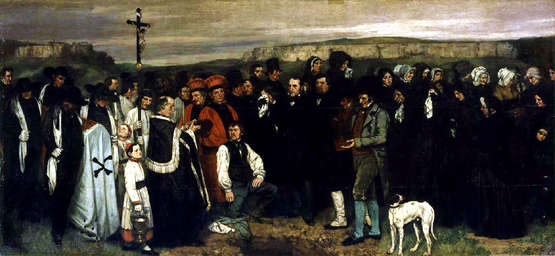 |
| Pictured: l’Enterrement à Ornans / Burial at Ornans (1849–1850) |
Courbet, a self-described Realist (who's credited with coining the term) is perhaps best known for his l’Enterrement à Ornans ("Burial at Ornans") from 1849–1850), and L’Atelier du peintre ("The Painter’s Studio") from 1854–1855, if not most for the controversial L'Origine du monde ("The Origin of the World") from 1866.
As the paintings chronicle, Courbet kept pushing viewers: using models not as stand-ins for historical figures but just as themselves, borrowing visual techniques from photography, displaying overt depictions of female sexuality, and in later life, making oblique references to the repressive atmosphere of post-Commune France which left him imprisoned and then in debt for his role in having helped raze the Vendôme Column, a symbol of the Napoleonic era.
One painting especially catches my eye, of his sister Zélie Courbet. Her face emerges as if cut from shadow. The interplay with the photography of the era — and vice versa — is striking, and also highlighted by the paintings' frequent juxtaposition with numerous contemporary photographs. Some photographers literally chronicled the same patch of forest, in dialog with the painter, or vice versa. Meanwhile, a number of stereoscopic images of prostitutes, which recall “The Origin of the World,” point to a different type of inspiration.
Courbet at the Galeries Nationales du Grand Palais (3, avenue du Général Eisenhower, Paris 8e), through January 28, 2008
The Paris Pinacothèque is staging the first large exhibition devoted to the Expressionist painter Chaïm Soutine (1893–1943) since a 1973 retrospective at the Orangerie. Much of this painting seems hauntingly "modern" — akin to a recent graphic novel cover from Dave McKean, not work from eighty years ago. Take “La Fillette à la robe rose” (c 1928): a cartoon-faced girl, ethereal, emerging behind layers of color.
Soutine at the Pinacothèque (28, Place de la Madeleine, Paris 8e), until January 27, 2008
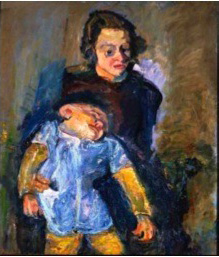 |
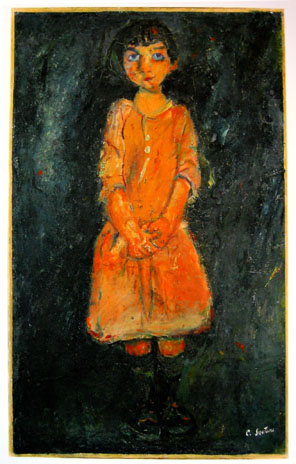 |
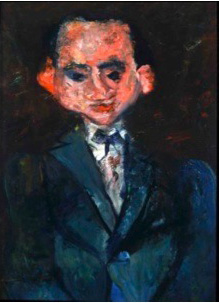 |
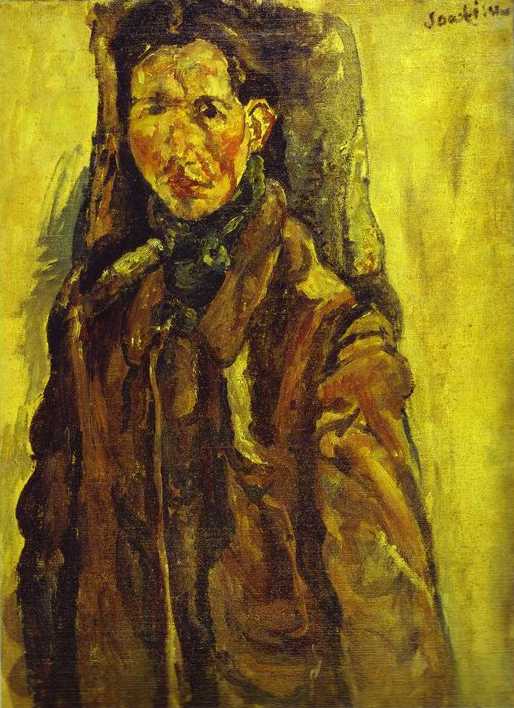 |
Selections of Soutine’s work (from left): Maternité (c 1942); La fillette à la robe rose (c. 1928); |
|||
One Jump, by Alex Majoli (Magnum) at the Paris Pinacothèque
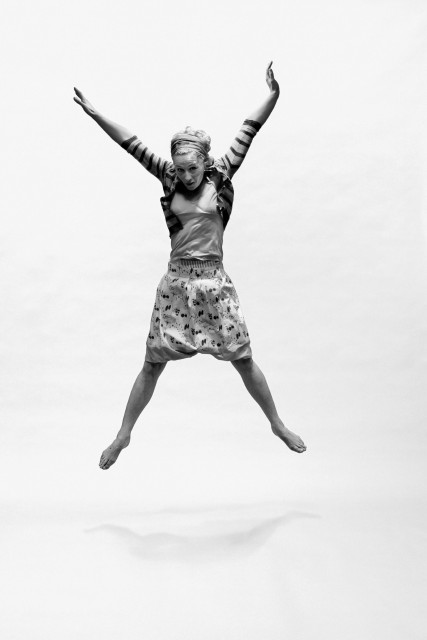 |
| Pictured: Cécile de France (2007), © Alex Majoli, Magnum Photos |
On a more modern note, also at the Pinacothèque is “One Jump,” a series of photos by Magnum photographer Alex Majoli from the 2007 Cannes Festival, commissioned to celebrate the festival’s 60th anniversary. Majoli dubs the staging of the black and white photographs — featuring actors, actresses and other celebrities leaping against an all-white backdrop — a tribute to Philip Halsman, a “cult photographer” from the 1960s known for his “Jumpology” series, which aimed to strip celebrities of their artifice.
The title for the exhibition hails from subject Al Gore, who said, “I will do it, but … only one jump!”
Despite Quentin Tarantino hanging in an effortless mid-air crouch, or the surprising grandeur of a former vice president, likewise captured floating above the ground, my award for best model goes to Anouk Aimée, who manages a smidgen of verticality while remaining poised. As usual.
“One Jump,” at the Paris Pinacothèque (28, Place de la Madeleine, Paris 8e), until February 10, 2008